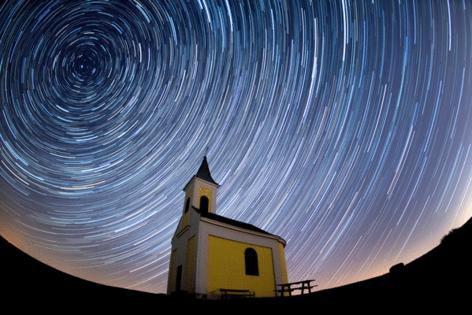The Lyrid meteor shower creates a light show for Earth Day. Here's how to get the best view
Published in News & Features
LOS ANGELES — Shooting stars will usher in Earth Day starting late Monday night as the Lyrid meteor shower reaches its peak — and Californians will have some of the best views in the country.
The annual meteor shower event will be most visible in April and is named after the constellation Lyra, the harp, located near the point in the sky where the Lyrids appear to originate. The shower is one of the oldest on record, with observations dating back more than 2,700 years.
The peak of the event will be Monday night into the early morning hours of Tuesday, Earth Day. Thanks to clear skies, almost all of California is forecast to have good viewing conditions, along with some regions of other western states, parts of the Southwest and a pocket of the Midwest, including areas west and south of Chicago, according to AccuWeather.
In Los Angeles and other major cities where light pollution is pervasive, stargazers will have some difficulty seeing the shower despite the ideal weather conditions due to the light pollution from homes, businesses, streetlights and cars.
"These events are notoriously invisible for the average person because we're all drowning in artificial light, and so there's really not a prayer for most people to get to see this at all," said Ed Krupp, the director of Griffith Observatory.
To get a clearer view of the stars, Krupp suggests those in Southern California should head out to the mountains or desert. Once hopeful viewers are "far from urban encroachment," their chance of catching more shooting stars is much better, he said.
Krupp, who's been serving as the iconic L.A. observatory's director since 1974, said it's important for people to temper their expectations of what they could see from the meteor shower.
"The very name sort of suggests that there are meteors pouring down on you," he said. "You're not likely to see more than one meteor a minute, and the Lyrids are not that populous, so the average time between one and then the next might be three minutes or so. It's a process that demands patience and attention."
The name "meteor shower" might also incorrectly imply that what viewers are seeing are meteors themselves, or the leftover comet particles and bits from broken asteroids, instead of the trail left behind them. "You're seeing a glowing tunnel of hot air that might be 10 miles in diameter produced by this very tiny little pebble that's passing through the atmosphere and burns up," Krupp said.
Still, Krupp said seeing just one shooting star is a special experience, and one that will often elicit cheers if you're in the company of other stargazers. He described the celestial lights as "charmers," saying there is an "emotional, uplifting" feeling you get when you witness one pass through the sky.
Krupp's best tips for an optimal viewing experience include dressing warm and making yourself as comfortable as possible, given that dedicated viewers could be staring up at the sky for at least a few hours, going well past midnight. Shooting stars can be easy to miss, he added, so staying focused and being patient are key. He warns against cell phone use, both because of the light it emits and the distraction it causes.
With the peak of the shower coming during the first few hours of Earth Day, Krupp chuckled at the alignment of the galaxy's display and our observance of the holiday.
"The cosmos is a cold, random and uncaring place, but somehow it manages to converge with our own emotional bonds," he said.
©2025 Los Angeles Times. Visit at latimes.com. Distributed by Tribune Content Agency, LLC.







Comments